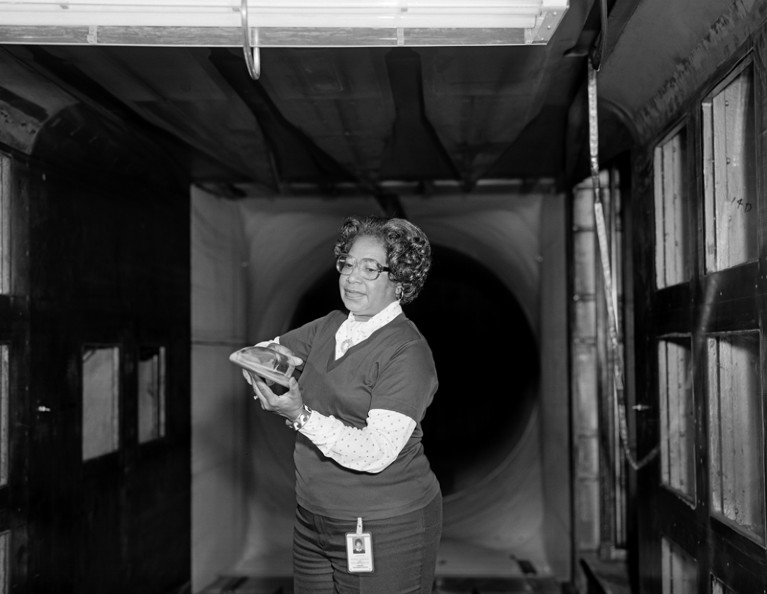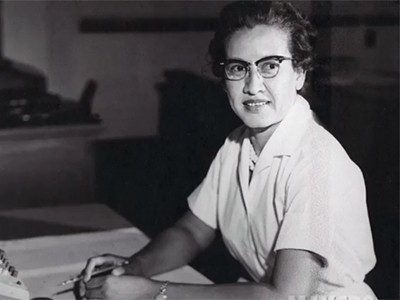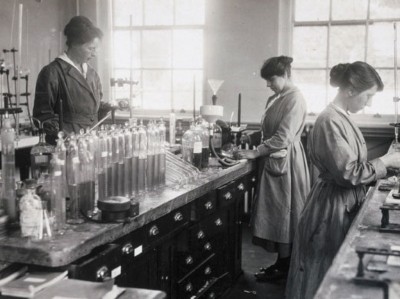
Mary W. Jackson’s contributions to engineering have been recognized in the naming of NASA’s headquarters building.Credit: NASA Langley Research Center
Last month, NASA named its Washington DC headquarters building after the late Mary W. Jackson, the agency’s first Black female engineer and an aeronautics expert who specialized in how air flows around aircraft. It was a poignant moment, because this recognition for Jackson comes more than a decade after she died, in 2005. Indeed, her achievements might not have had such exposure had it not been for Margot Lee Shetterly’s 2016 book, Hidden Figures, and the accompanying film released in the same year. Both recounted the story of a group of Black female mathematicians, including Jackson, who worked at the Langley Research Center in Hampton, Virginia.
Naming a government building in Washington DC after Jackson is noteworthy, but it is just one small step towards addressing wider problems in the study of the history of science and engineering. As Women’s History Month draws to a close, we are very conscious of how the science-history literature — including much of the Nature archive — has failed to recognize the achievements of female researchers, and particularly those from marginalized communities. Their work has long been obscured, and sometimes even eliminated from the record, but initiatives are now under way to right this wrong.
As in most fields, it is men — often white men and men from institutions in high-income countries — that dominate the community of science historians and the scholarship produced in history-of-science journals. And the exclusion of female historians has been exacerbated by the COVID-19 pandemic. The history-of-science journal Isis has seen a sharp fall in the number of women submitting manuscripts. Female and male authors submitted papers in equal numbers in January and February 2020, but since March that year, male authors have outnumbered female authors by more than three to one, probably because more women than men shouldered caring and domestic responsibilities once lockdowns began.
However, a new generation of science historians is emerging, with potentially mould-breaking consequences. Nature spoke to several of these researchers, both women and men. They described the roots of some of the problems, and highlighted a number of efforts towards a more diverse, inclusive and global history of science.
Breaking barriers: the US space programme’s black women mathematicians
The researchers reiterated how much of the literature in science and engineering history is framed around a narrative of the ‘great hero scientist’ — a man who often makes breakthroughs by himself, on the strength of some special insight or individual genius. Where the records show collaborators, these people are also more likely to be men. None of this is new, or surprising. Science is rife with racism and sexism. Throughout history and around the world, science has continued while women have been denied access to educational opportunities; laboratory and field work; and the institutional structure of academia, publications and learned societies. Contributions from women, especially women of colour, have often been obscured, if not deliberately erased.
Cairo-based historian Heba Abd el Gawad, at University College London, recounts the story of a female excavator from the 1880s who worked with Egyptologist and eugenicist Flinders Petrie. Sadly, we will never know who she was because the records list only her father’s name — Mohammed Hassan. She would have needed to provide his name to secure a job, a practice that still exists in some countries. Petrie never bothered to ask his female colleague’s real name, el Gawad explains.
Unconventional sources
In science history, the archival manuscript is one of the main sources of evidence on which research — and, indeed, entire careers — is constructed. In today’s context, such documents are the equivalent of a journal article or an academic monograph. So if historians are to take a more inclusive approach, the sources of evidence will need to be expanded, by searching for voices that have been silenced and acknowledging contributions that have been denied. That is now starting to happen.
Oral histories in different languages can serve as sources of information, and so can personal artefacts, which can be incorporated into archives, says Sarah Qidwai, a historian at the University of Toronto, Canada. An upcoming five-volume encyclopedia — a collection of primary sources of material from female scientists, including written sources, images and links to audio and other material — is due to be published in the next few years. This work, provisionally titled Gender, Colonialism, and Science, 1750–1950, is being edited by Donald Opitz, a historian at DePaul University in Chicago, Illinois, and Banu Subramaniam, a biologist and gender-studies scholar at the University of Massachusetts Amherst.
Women in science: A temporary liberation
Hidden figures will not be found without stretching the archive, says Emily Rees, who researches women and technology at the University of Leeds, UK. Rees and her colleagues are trying to do just that with their Electrifying Women project: they’re searching conference archives and other under-explored sources for information about the contributions of female engineers from outside Europe and North America.
Leadership institutions involved in the history of science are also starting to move. Last July, the British Society for the History of Science held a global digital festival that tackled questions such as how to identify under-represented voices in archive material. At universities, exciting collaborations are forming between faculty members and students, such as the student-led project Science Beyond the West at the University of Pennsylvania in Philadelphia.
All this work takes time, organization, funding and recognition of the importance of incorporating perspectives from researchers who have long been marginalized. This doesn’t necessarily mean coming up with a fresh list of ‘unsung geniuses’ to add to the great-hero narrative. As historian Patricia Fara, at the University of Cambridge, UK, has noted, biographies of female scientists can also perpetuate stereotypes. All fields of history are going through a process of reflection and change. Science’s history should be no different if women are to get the recognition they deserve.

 Breaking barriers: the US space programme’s black women mathematicians
Breaking barriers: the US space programme’s black women mathematicians
 Women in science: A temporary liberation
Women in science: A temporary liberation
 Women in science: Weird sisters?
Women in science: Weird sisters?
 Global Darwin: eastern enchantment
Global Darwin: eastern enchantment






